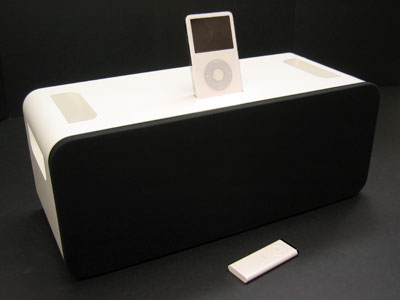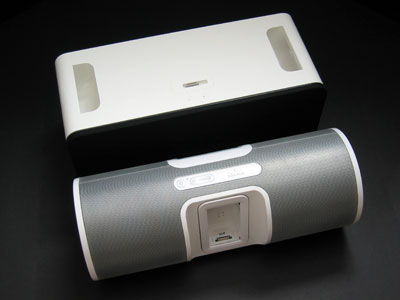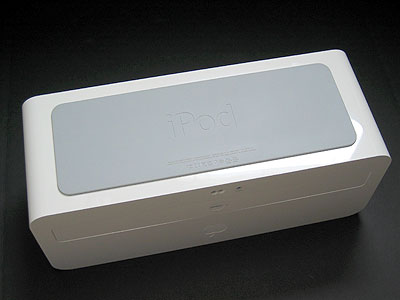Apple Computer iPod Hi-Fi Speaker System-Mp4Converter.net
Updated March 12,2006
Pros:
A powerful single-enclosure iPod-docking speaker system that delivers superior midrange and bass detail at high volumes, rivalling or exceeding the peak performance of low-end 2.1-channel audio systems with separate components. Simple controls and an included six-button Apple Remote make system easy to use. Runs off of wall power or batteries and includes carrying handles, thereby semi-portable. Charges iPod with wall or battery power.
Cons:
Top existing all-in-one iPod speaker systems deliver better dynamic range (particularly treble response) at close distances; our favorites also include independent, incremental bass and/or treble controls. No video or data ports on back. Staid design, high price, and top-mounted iPod dock detract from appeal. Nearly seventeen-pound weight with batteries renders it the heaviest of all semi-portable speakers we’ve seen.
Review:
In order to fully understand our perspective on Apple Computer's new iPod Hi-Fi ($349), a new all-in-one speaker system with an iPod dock on top, you'll need to put aside both the hype surrounding its announcement, and the highly critical response its design and pricing have thus far received. Speakers should never be judged by their marketing, nor criticism from those who haven't heard them. And in this case, you'll also have to avoid the obvious - seeing iPod Hi-Fi as a direct competitor to existing iPod desktop speakers such as Altec Lansing's inMotion iM7, Bose's SoundDock, and JBL's On Time . They'll all compete for your dollars, but they're actually very different types of listening devices.

As suggested but not fully explained during Apple's unveiling, iPod Hi-Fi is designed for a "ten foot" listening experience - not ten inches or two feet, but ten or more. It is also the most austere-looking iPod listening device yet released, which is really saying something given the intentionally stark look of Bose's earlier SoundDock, and the beauty of Altec's iM7 and JBL's On Time. For these reasons, it will neither look nor sound its best sitting right next to you, on your desk, or on the floor; Apple actually suggests you place the speaker at ear level, specifically on a "stable, hard surface, away from floor and ceiling," with "room to breathe on all sides." This largely explains why the device was initially demonstrated by the company at the far ends of four large rooms: it is a simple but undeniably powerful audio source, designed primarily as a substitute for the separate speakers and amplifier of a 2.1-channel home stereo system, rather than as a boombox or table radio. It also includes its own remote control, which is literally necessary to take advantage of its horsepower.
There are, however, a few problems. Apple has rhetorically placed itself in competition with virtually every premium iPod speaker by touting iPod Hi-Fi as an "audiophile-quality" system that can go "on the road" with D batteries. In this way , the company simultaneously sparked debates on appropriate iPod speaker pricing, practicality, and quality. Most riled up were notoriously finicky audiophiles, who immediately seized upon Hi-Fi's size and specifications to suggest that it would never meet their needs. Some correctly questioned whether "audiophile-quality" sound is necessary or desirable for typical iPod users, whose collections consist of compressed, distorted music. Still others saw the $349 price point as ridiculous given the large number of more affordable systems, including attractive, great-sounding options like Altec's iM7 (below). And no matter how angry or confused people may be, virtually everyone has the same question: how does Apple's first iPod speaker system actually sound?

Our comprehensive review below considers each of these key issues, and more. As with other significant reviews we've posted recently, this one's broken up into a number of key clickable sections that you can expand based on your specific needs and interests. We hope that you find it useful.
Conclusions
If sustained sound quality at high volumes was the only measure of a great iPod speaker system, ratings would be easy to assign, and iPod Hi-Fi would be at or near the top of the pile. In fact, the iPod-specific speaker market has grown so considerably over the past three years that some people may want it only for this reason, and we certainly wouldn't dissuade them - or other readers - from giving iPod Hi-Fi a try. Apple Stores will no doubt stock all of the speakers we've referenced above, so if you're really curious enough to try them for yourself, we'd advise you to try systematic tests: the same song on each system at the same volume, with the iPod's equalizers off and the speaker's own equalizers set to your preferred settings. That way, you can get an idea of what's best for you.

From our perspective, however, the aggregate assessment of a speaker system should also take into account factors such as typical-volume performance, dynamic range, pricing, design, size, and practicality. Considering all of these factors, and despite its good (if warm) low-volume sound and strong performance at high volumes, iPod Hi-Fi falls somewhere in the middle of the semi-portable speaker pack. Because of its comparatively high price, staid design, and underwhelming treble response, it's hard to recommend to typical iPod users over Altec's inMotion iM7, Bose's SoundDock, or JBL's On Time for most of their listening purposes. Even Klipsch's iFi has recently fallen in price to as little as $200, making it a comparatively aggressive alternative to iPod Hi-Fi. Except when placed at the far end of a large room and cranked up, these options will provide listeners with great audio experiences at lower - potentially considerably lower - asking prices. It's hard to believe we're saying this about an Apple product, but pay the Hi-Fi's premium only if you really need the extra horsepower and don't mind its extra size and weight.
As some people have ever suggested, it's hard not to feel like something is missing from iPod Hi-Fi - not just video or data ports, or an RF remote control, any of which would have been useful. Rather, Apple needed a big feature to justify its big asking price, like an internal AirPort Express for wireless iTunes integration, or the cutting-edge, paradigm-shifting industrial design we've come to expect from the company's products. They're nowhere to be found. And so, apart from its raw power, which won't be useful for many people, the only stand-out feature here is the optical audio-in option, which iPod-only users currently have no reason to try.
For these reasons listed above, we consider iPod Hi-Fi to be a missed opportunity for Apple, and one that would benefit tremendously from evolving into a wireless-enabled version 2. Until then, it's a speaker system that will satisfy the audio needs of certain listeners - and good enough to earn our general recommendation - but it will also give most of the iPod third-party accessory development community reason to breathe a sigh of relief.
Related Product: 4Media iPod Max Platinum for Mac
Mac Software
Hot Suite
- More for Less Promotion
- DVD to iPod Suite for Mac
- Mac DVD Toolkit
- iPhone Software Suite for Mac
- Media Toolkit Ultimate for Mac
MP4 Software
iPad/iPhone/iPod Software
- iPad Max Platinum for Mac
- DVD to iPad Converter for Mac
- iPad to Mac Transfer
- iPad Max for Mac
- iPad Video Converter for Mac
- iPhone Max Platinum for Mac
- iPhone Max for Mac
- iPhone Apps Transfer for Mac
- iPhone Ringtone Maker for Mac
- iPhone Video Converter for Mac
- iPhone to Mac Transfer
- iPod Max Platinum for Mac
- iPod Max for Mac
- iPod Video Converter for Mac
- DVD to iPod Converter for Mac
- iPod to Mac Transfer
Video Converter
- Video Converter for Mac
- Movie Editor for Mac
- HD Video Converter for Mac
- Apple TV Video Converter for Mac
- Online Video Converter for Mac
- Video Editor for Mac
- HEVC-H.265 Converter for Mac
DVD/CD/Blu Ray Software
Windows Software
Hot Suite
iPad/iPhone/iPod Software
- iPad Max Platinum
- iPad Max
- iPad Video Converter
- iPad to PC Transfer
- iPhone Apps Transfer
- Blu-ray to iPad Converter
- YouTube to iPad Converter
- iPhone Max Platinum
- iPhone Ringtone Maker
- iPhone Video Converter
- iPhone Transfer
- iPhone Contacts Transfer
- iPod Max Platinum
- iPod to PC Transfer
- iPod Video Converter
Video Converter
- Video Cutter 2
- Video Converter
- Online Video Converter
- HD Video Converter
- 3GP Video Converter
- MP4 to MP3 Converter
- MP3 Converter
- MP4 Converter
- PS3 Video Converter
- DPG Converter
- HEVC/H.265 Converter
DVD/CD/Blu Ray Software
PPT/PDF Software
Articles
- How to download YouTube videos for free
- How to download/convert YouTube videos to iPod
- How to download and convert YouTube videos
- All features of apple iPhone
- Now you can get more TV offerings from Apple iTunes
- Video Streamer HAVA from Snappy Multimedia
- iPod Growth Driving Demand for Flash Memory
- MediaMan HVX-3500 Review
- Uncertain whether new iPod will be delayed or not because of hurdles
- T3's top five iPod alternatives
- Envivio Exhibits MPEG-4 Solutions from Mobile to HD at CCBN2006

